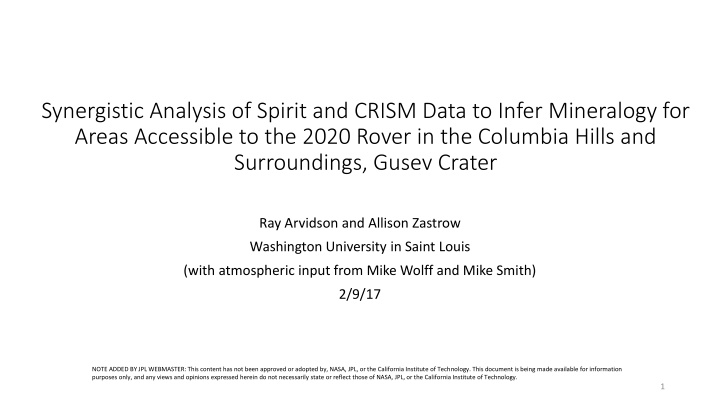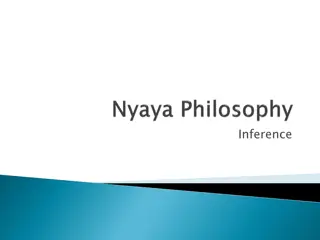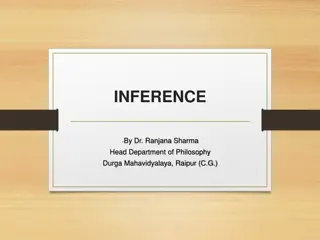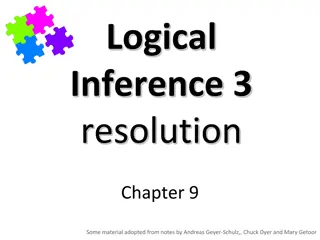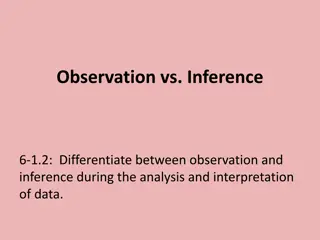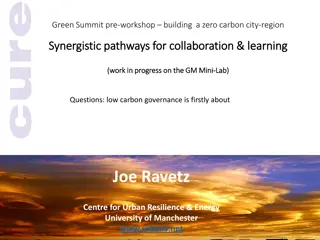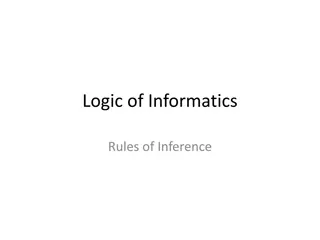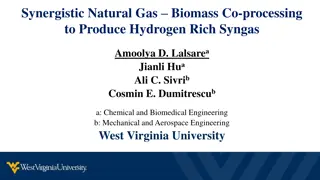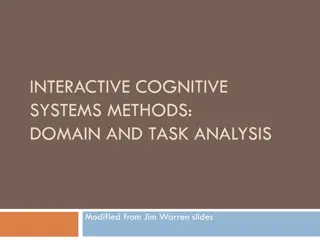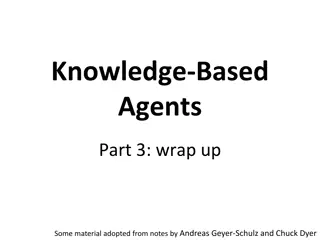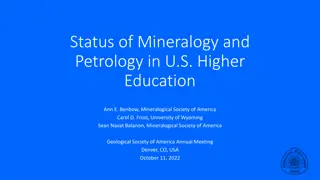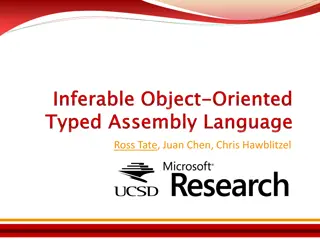Synergistic Analysis of Spirit and CRISM Data for Mineralogy Inference in Gusev Crater
"Exploring aqueous alteration and mineralogy in Gusev Crater's Columbia Hills using Spirit and CRISM data analysis. Challenges in identifying minerals, CRISM data regularization techniques, and comparison with Nili Fossae Trough. Active aeolian processes and dust cover impact mineral mapping feasibility."
Download Presentation

Please find below an Image/Link to download the presentation.
The content on the website is provided AS IS for your information and personal use only. It may not be sold, licensed, or shared on other websites without obtaining consent from the author.If you encounter any issues during the download, it is possible that the publisher has removed the file from their server.
You are allowed to download the files provided on this website for personal or commercial use, subject to the condition that they are used lawfully. All files are the property of their respective owners.
The content on the website is provided AS IS for your information and personal use only. It may not be sold, licensed, or shared on other websites without obtaining consent from the author.
E N D
Presentation Transcript
Synergistic Analysis of Spirit and CRISM Data to Infer Mineralogy for Areas Accessible to the 2020 Rover in the Columbia Hills and Surroundings, Gusev Crater Ray Arvidson and Allison Zastrow Washington University in Saint Louis (with atmospheric input from Mike Wolff and Mike Smith) 2/9/17 NOTE ADDED BY JPL WEBMASTER: This content has not been approved or adopted by, NASA, JPL, or the California Institute of Technology. This document is being made available for information purposes only, and any views and opinions expressed herein do not necessarily state or reflect those of NASA, JPL, or the California Institute of Technology. 1
Overview Spirit on the plains and within the Columbia Hills in Gusev Crater found ample evidence for aqueous alteration of soils and rocks On the other hand active aeolian processes, dominance of basaltic materials, variable dust cover, small outcrops with aqueous minerals (also sulfates buried and only exposed by wheels) make identification and mapping of aqueous minerals difficult to impossible using orbital spectroscopic methods (TES, OMEGA, CRISM), particularly as compared to other 2020 rover candidate landing sites Use log maximum likelihood regularization of CRISM data to retrieve best estimate of surface reflectance in presence of noise to illustrate issues - DISORT modeling of gas and aerosols with Hapke surface function to retrieve surface single scattering albedo (SSA) spectra - Log maximum likelihood recursive regularization (remove spatial and spectral transfer functions) with side penalties to retrieve SSAs, which are independent of atmospheric conditions and lighting and viewing conditions (facilitates direct comparisons scene to scene) - Compare CRISM-based mineral inferences for Gusev (including area around Comanche, Spirit- based discovery of Fe-Mg carbonates) and Nili Fossae Trough 2
11/22/2006 Ls=139 Tdec,L=-163 C 3
9/21/2008 Ls=130 Tdec,L=-154 C Spectral comparison 4
11/12/2012 Ls=200 Tdec,L=-147 C Dust devil tracks removing dust cover Gusev is an active aeolian site with variable dust cover 6
Key Spirit sites Note bland nature of this SSA color composite using linear stretch and 20% transparency over CTX 7
Pancam Enhanced Color Mosaic from Husband Hill Looking South into the Inner Basin Home Plate (~80 m wide) Spirit s final location Variable dust cover over basaltic sand, rocks, and outcrop Husband Hill 8
HiRISE View PSP_001513_1655_red.jp2 Fe-Mg carbonate locality based On Spirit data (Morris et al., 2010) ~100 m wide 9
South Downhill Spirit contact science measurements Sol 697-700 Navcam Mosaic Comanche outcrops 10
5 pixel means of area around Comanche and downhill in SSA and SSA/column means FRT0003192 L Data RGB 2.5194, 1.5065, 1.0601 m SSA SSA MLM 0.016 Difference because MLM removes Spatial transfer function Very shallow features! H2O Artifact CO3 0.01 Artifact Very difficult to find other believable signatures of aqueous minerals In this and other CRISM scenes covering the Columbia Hills. Very shallow absorption features indeed. Consistent with bland nature of the false color composite. Similar to what Carter and Poulet (2012) reported 11
25 pixel means SSA Values Fe-Mg Smectites 12/17/2015 Ls=82 Tdec,L=-148 C H2O 0.06 M-OH Fe-Mg smectites Low Ca pyroxene Low Ca pyroxene Olivine-pyroxene Fe2+ Fe2+ absorptions continue in S band Olivine-pyroxene Fe2+ absorptions continue in S band Fe2+ Same transparency factor and contrast stretch as used for Gusev scenes. Note the variety of colors relative to the Columbia Hills scene. And deep absorption features far above noise levels in example spectra. 12
Summary for Gusev 2020 Rover Candidate Landing Site Spirit found ample evidence for aqueous alteration of soils and rocks either by excavation from subsurface by wheels or investigating relatively small outcrops Aeolian activity, the dominantly dusty and/or basaltic nature of the surface, small areal exposures, and subsurface deposits (sulfates) make for spectrally bland surfaces as compared to other candidate 2020 rover landing sites - Lacks the strong orbital aqueous mineral detections that have been proven to be of high value for directing Opportunity and Curiosity to key outcrops relevant to meeting mission objectives As a consequence Spirit does not rate highly to us as a 2020 rover landing site Plus what will we learn from the 2020 rover in the Columbia Hills that Spirit has not already told us? 13
